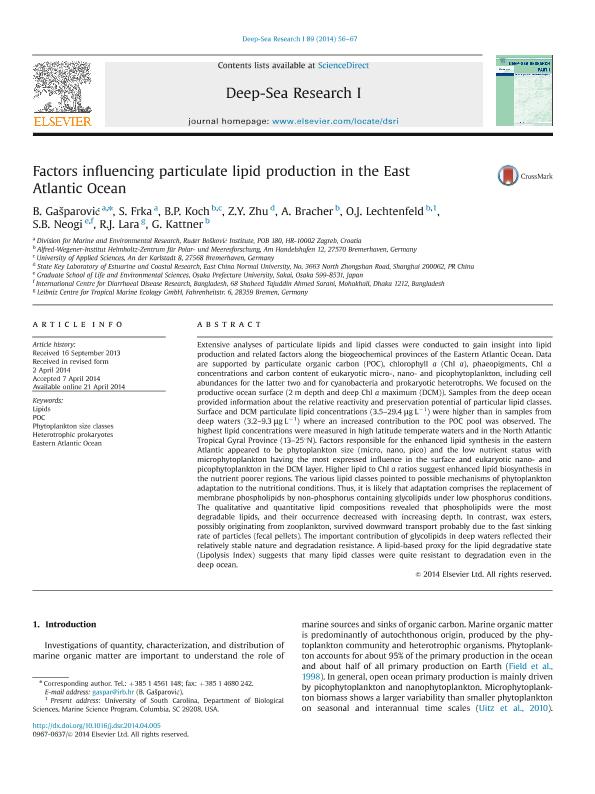Mostrar el registro sencillo del ítem
dc.contributor.author
Gašparović, B.
dc.contributor.author
Frka, S.
dc.contributor.author
Koch, B. P.
dc.contributor.author
Zhu, Z. Y.
dc.contributor.author
Bracher, A.
dc.contributor.author
Lechtenfeld, O. J.
dc.contributor.author
Neogi, Sucharit Basu

dc.contributor.author
Lara, Ruben Jose

dc.contributor.author
Kattner, G.
dc.date.available
2017-01-16T17:44:03Z
dc.date.issued
2014-04
dc.identifier.citation
Gašparović, B.; Frka, S.; Koch, B. P.; Zhu, Z. Y.; Bracher, A.; et al.; Influential factors for the particulate lipid production in the East Atlantic Ocean; Elsevier; Deep Sea Research Part I: Oceanographic Research Papers; 89; 4-2014; 56-67
dc.identifier.issn
0967-0637
dc.identifier.uri
http://hdl.handle.net/11336/11383
dc.description.abstract
Extensive analyses of particulate lipids and lipid classes were conducted to gain insight into lipid production and related factors along the biogeochemical provinces of the Eastern Atlantic Ocean. Data are supported by particulate organic carbon (POC), chlorophyll a (Chl a), phaeopigments, Chl a concentrations and carbon content of eukaryotic micro-, nano- and picophytoplankton, including cell abundances for the latter two and for cyanobacteria and prokaryotic heterotrophs. We focused on the productive ocean surface (2 m depth and deep Chl a maximum (DCM)). Samples from the deep ocean provided information about the relative reactivity and preservation potential of particular lipid classes. Surface and DCM particulate lipid concentrations (3.5–29.4 μg L−1) were higher than in samples from deep waters (3.2–9.3 μg L−1) where an increased contribution to the POC pool was observed. The highest lipid concentrations were measured in high latitude temperate waters and in the North Atlantic Tropical Gyral Province (13–25°N). Factors responsible for the enhanced lipid synthesis in the eastern Atlantic appeared to be phytoplankton size (micro, nano, pico) and the low nutrient status with microphytoplankton having the most expressed influence in the surface and eukaryotic nano- and picophytoplankton in the DCM layer. Higher lipid to Chl a ratios suggest enhanced lipid biosynthesis in the nutrient poorer regions. The various lipid classes pointed to possible mechanisms of phytoplankton adaptation to the nutritional conditions. Thus, it is likely that adaptation comprises the replacement of membrane phospholipids by non-phosphorus containing glycolipids under low phosphorus conditions. The qualitative and quantitative lipid compositions revealed that phospholipids were the most degradable lipids, and their occurrence decreased with increasing depth. In contrast, wax esters, possibly originating from zooplankton, survived downward transport probably due to the fast sinking rate of particles (fecal pellets). The important contribution of glycolipids in deep waters reflected their relatively stable nature and degradation resistance. A lipid-based proxy for the lipid degradative state (Lipolysis Index) suggests that many lipid classes were quite resistant to degradation even in the deep ocean.
dc.format
application/pdf
dc.language.iso
eng
dc.publisher
Elsevier

dc.rights
info:eu-repo/semantics/openAccess
dc.rights.uri
https://creativecommons.org/licenses/by-nc-nd/2.5/ar/
dc.subject
Atlantic Ocean
dc.subject
Organic Matter
dc.subject
Lipids
dc.subject
Phytoplankton
dc.subject.classification
Oceanografía, Hidrología, Recursos Hídricos

dc.subject.classification
Ciencias de la Tierra y relacionadas con el Medio Ambiente

dc.subject.classification
CIENCIAS NATURALES Y EXACTAS

dc.title
Influential factors for the particulate lipid production in the East Atlantic Ocean
dc.type
info:eu-repo/semantics/article
dc.type
info:ar-repo/semantics/artículo
dc.type
info:eu-repo/semantics/publishedVersion
dc.date.updated
2016-12-01T19:39:02Z
dc.journal.volume
89
dc.journal.pagination
56-67
dc.journal.pais
Países Bajos

dc.journal.ciudad
Amsterdam
dc.description.fil
Fil: Gašparović, B.. Ruder Boskovic Institute; Croacia
dc.description.fil
Fil: Frka, S.. Ruder Boskovic Institute; Croacia
dc.description.fil
Fil: Koch, B. P.. Alfred Wegener Institute; Alemania. University of Applied Sciences; Alemania
dc.description.fil
Fil: Zhu, Z. Y.. East China Normal University; China
dc.description.fil
Fil: Bracher, A.. Alfred Wegener Institute; Alemania
dc.description.fil
Fil: Lechtenfeld, O. J.. Alfred Wegener Institute; Alemania
dc.description.fil
Fil: Neogi, Sucharit Basu. International Centre For Diarrhoeal Disease Research; Japón. Osaka Prefecture University; Japón
dc.description.fil
Fil: Lara, Ruben Jose. Consejo Nacional de Investigaciones Científicas y Técnicas. Centro Científico Tecnológico Bahía Blanca. Instituto Argentino de Oceanografía (i); Argentina. Leibniz Centre for Tropical Marine Ecology; Alemania
dc.description.fil
Fil: Kattner, G.. Alfred Wegener Institute; Alemania
dc.journal.title
Deep Sea Research Part I: Oceanographic Research Papers

dc.relation.alternativeid
info:eu-repo/semantics/altIdentifier/url/http://www.sciencedirect.com/science/article/pii/S0967063714000557
dc.relation.alternativeid
info:eu-repo/semantics/altIdentifier/doi/http://dx.doi.org/10.1016/j.dsr.2014.04.005
Archivos asociados
